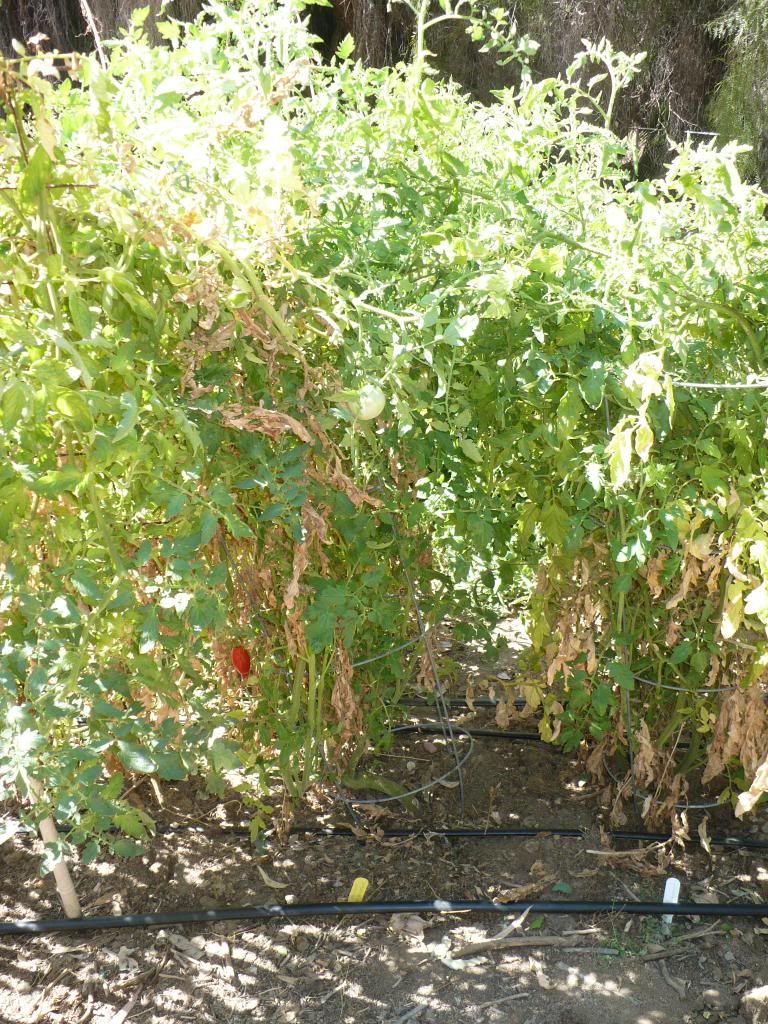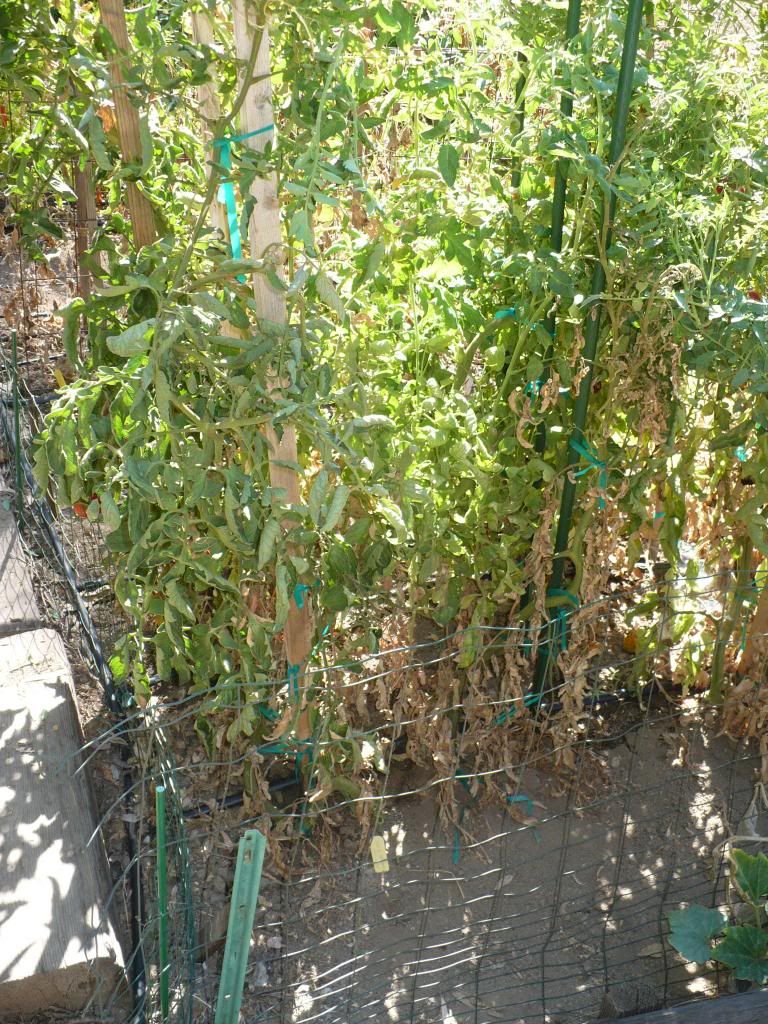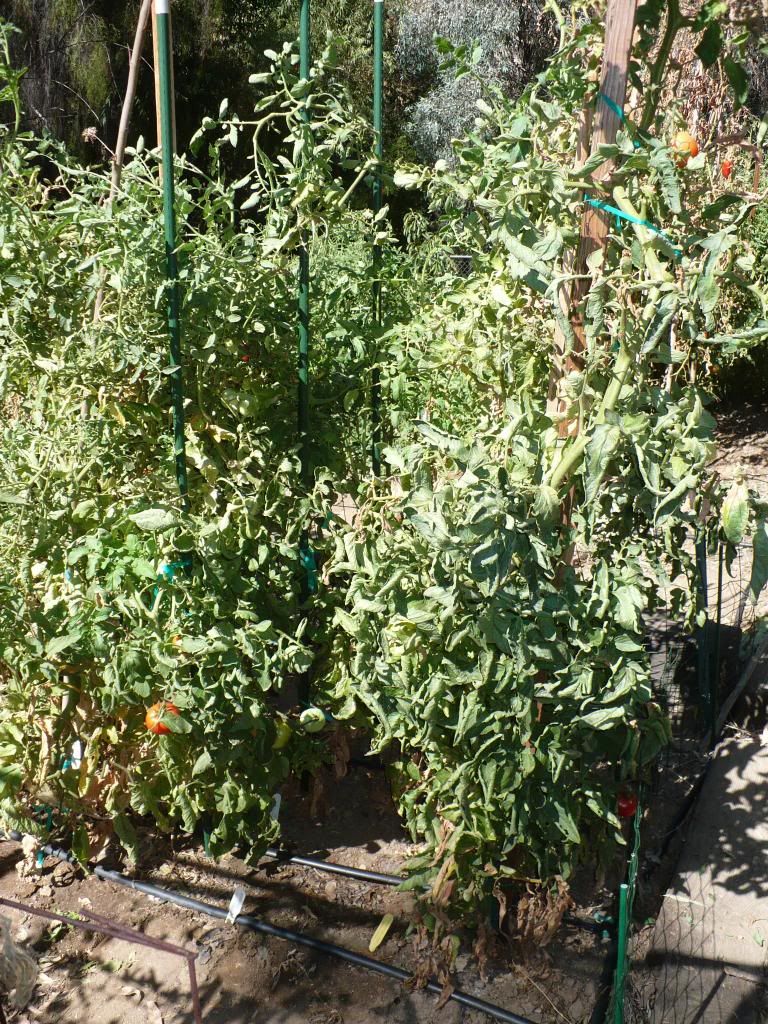

|
|
#76 |
|
Tomatovillian™
Join Date: Feb 2010
Location: Merced, CA
Posts: 832
|
Hi Raybo,
Never heard of that variety before. Very impressive! You'll have to let us know how it tastes  ! !Not to detract from the beauty of the tomatoes, but I was wondering about the brown leaves in the photo. I have many of those also and (I really feel dumb here), I'm not sure if it's anything to be concerned about. I'm assuming it's just a combination of heat, sun exposure, and natural leaf "mortality." Is this correct (I've just been cutting them off). Also, how's the rest of your garden doing? I've been gradually yanking out plants, getting ready for a fall garden, and some of the tomatoes are looking pretty sad! (I ask you as we're sort of in the same general area). Thanks! Anne |
|
|

|
|
|
#77 |
|
Tomatovillian™
Join Date: Apr 2007
Location: Campbell, CA
Posts: 4,064
|
Anne,
The taste was fair - not as good as Momotaro, MarNar, or Desters. I gave about 20 pounds of them to my neighbor who was from Rome. She made wonderful sauce from them.  I stopped all spraying (Daconil, Take Down) back in late May after fruitset began, so I am paying the price right now in high insect and foliar damage.  I have 10 new plants about ready as my replacement plantings to hopefully get a decent Fall/Winter crop. Cukes and corn doing great. Raybo 
|
|
|

|
|
|
#78 |
|
Tomatovillian™
Join Date: Jun 2011
Location: Eastern Suburb of Sacramento, CA
Posts: 1,313
|
Raybo, great stuff as always. Thanks for posting.
I took this picture yesterday before tearing down this Absynth vine grafted to a Maxifort. It's main trunk looks like a young sapling's. At over 2" in diameter, it's rightly the thickest I've encountered on a tomato vine. Just amazing. The plant did fairly well for me and probably put out 20+lb of GWR tomatoes. I didn't like their shelf-life, though they taste great for about a day if picked at just the right time. That said, they'll not be returning to my garden in the near future. I had to tear this plant out because it had become completely infested by mites and some other bugs of various sizes. It was nearly completely fried by the buggers. I haven't sprayed anything for months now, so this is the outcome. |
|
|

|
|
|
#79 |
|
Tomatovillian™
Join Date: Jun 2011
Location: Eastern Suburb of Sacramento, CA
Posts: 1,313
|
I know I haven't kept up on my promise to post pictures of the grafted tomatoes in my garden. I've been busy trying to install solar on my roof (and a friend's) this past month. On the plus side, I did snap a few pics of the garden from my sky view. Not the best pics, but you can see the lay of the land. The tomatoes have been suffering pretty heavily for a while now. Production is down to about 1% of their top producing days. Lots of BER and cracked inedible stuff. Lots of disease. I haven't been watering, spraying, or otherwise treating these guys too well at all. The peppers are still doing ok, as I do water them daily. Still, this constant heat has taken a tool on the Bells. Without a shade cloth, the fruit they set just rot (cook) on the vine. Only those hidden by leaves seem to make it to maturity. The leaves seem to sag and cook too. And that's with daily watering and SWCs. Next year, I really need to figure out how to situate a shade cloth structure that allows me full access to the containers on my patio. This year, I've had the shade cloth hanging over the plants using their support cages as a structure. But then the plants grow too large and run into the shade cloth. It's not an ideal setup.
BTW, pic1 was taken on 7/23 and the other three on 8/17. You can really see the decrepitude that's crept up the vines between the three weeks of pic1 vs. pic2. Last edited by z_willus_d; August 19, 2013 at 12:20 PM. |
|
|

|
|
|
#80 |
|
Tomatovillian™
Join Date: Jun 2011
Location: Riverside, Southern California, USDA 9b, Sunset 19
Posts: 63
|
Very envious of the solar project something we need to get cracking on.
There was an interesting article about tomato production in the Sacramento region in the NY times the other day http://opinionator.blogs.nytimes.com...-food-is-evil/ I've also heard before that the majority of processed tomatoes in the US are grown in the Central valley. I'm always curious how they cope with the extreme temperatures and intense sun. Obviously they aren't using shade cloth. So how do they get get such good yields that its become seemingly one of the best places in the US to grow tomatoes for commercial production. I've also talked to farm advisors and they grow tomatoes in the Coachella valley down here in the low desert near Palm Springs where average temps are ridiculously high. Is it down to varieties, I've seem "Valley girl types", or just determinate vs indeterminate. They must have some strategy to get fruit set in high temps and good production. I'd be interested in any thoughts anyone has, or is it down to very different standards of production, all harvestable in one short intense period. |
|
|

|
|
|
#81 |
|
Tomatovillian™
Join Date: Jun 2011
Location: Eastern Suburb of Sacramento, CA
Posts: 1,313
|
David, this book should answer a lot of your questions about commercial tomato production:
http://www.amazon.com/Tomatoland-Ind.../dp/1449423450 If they can grow them in sandy, hot Floriea, they can grow them anywhere I bet. On the solar front, if you're really planning on installing the solar yourself (big $$ savings to be had if you do), I highly recommend you read through the following site: https://sites.google.com/site/sitechsolar/home This documents the process that my co-worker and I followed in our installations, and I/we haven't found any other resource with all this information contained in the same location. He was the one who put the site together, not me, BTW. Good luck! -naysen |
|
|

|
|
|
#82 |
|
Tomatovillian™
Join Date: Jun 2011
Location: Riverside, Southern California, USDA 9b, Sunset 19
Posts: 63
|
Thanks for the recommendation, have it on order from the library. I'll look into the solar link, probably beyond my skills i daresay.
|
|
|

|
|
|
#83 |
|
Tomatovillian™
Join Date: Feb 2010
Location: Merced, CA
Posts: 832
|
Hi,
DavidP, Interesting article! Thanks for posting the link. if you haven't already seen it, you might find the following article about tomato production in Merced County interesting: http://cemerced.ucanr.edu/files/40380.pdf On to the photos..... I did a KBX on Ping Tung Eggplant rootstock graft this year, and just let the eggplant rootstock that grew out below the graft continue to grow. The baby eggplant on the Ping Tung rootstock is finally "ready for its close-up." You can see the little critter on the left  ! The leaves of the eggplant are pretty ratty looking (I assume flea beetles), but it's doing quite well nevertheless and there are a number of potential buds about to emerge. ! The leaves of the eggplant are pretty ratty looking (I assume flea beetles), but it's doing quite well nevertheless and there are a number of potential buds about to emerge. I also have a close-up of the graft union. As you'll see in a later photo, but which isn't too clear in this photo, the eggplant rootstock has a much smaller diameter than the kbx, although they were both the same size at time of grafting. Then I have a view showing the entire plant, including a couple of green KBX fruit. Finally, I've got a view of a Prue on Ping Tung rootstock that I yanked out the other day. I never did get much production out of it. It's interesting (to me anyway) how fiberous the rootball is compared to my tomato rootballs. And, of course, you can really see the stem diameter differences in this photo. Will no doubt try some more combinations using eggplant next year. Sort of a fun thing to do! Enjoy! Anne |
|
|

|
|
|
#84 |
|
Tomatovillian™
Join Date: Feb 2010
Location: Merced, CA
Posts: 832
|
Hi,
I'm attaching a couple of photos of my most recent batch of grafts on RST-04-105-T. One pair is Fish Lake Oxheart, grafted and "natural" and the other is of Red Barn, grafted and "natural." The grafts were done at the 1.5mm clip stage. They took very quickly with no problems. I grafted them on the 18th, so today is day 10 and they've been out of the healing chamber for about 3 days now. (I had a photo of another set of grafts, but I realized they were different leaf types!!  I'm taking a number of meds of the "do not operate heavy machinery type" for various medical problems and I swear that they're making me stupid!!). I'm taking a number of meds of the "do not operate heavy machinery type" for various medical problems and I swear that they're making me stupid!!).At any rate, I think it's sort of noteworthy how at this very early stage there's not much difference between the grafted and ungrafted plants. In the grafts I did last spring, the grafted versions all seemed to take a while to catch up to their ungrafted versions. Anne |
|
|

|
|
|
#85 |
|
Tomatovillian™
Join Date: Jun 2011
Location: Eastern Suburb of Sacramento, CA
Posts: 1,313
|
Anne, thanks for posting the pics. I'm very interested in RST-04-105-T for a rootstock, so I'll be anxious to hear your results through the Fall season. Keep 'em coming.
-naysen |
|
|

|
|
|
#86 |
|
Tomatovillian™
Join Date: Jun 2011
Location: Riverside, Southern California, USDA 9b, Sunset 19
Posts: 63
|
Here's an update on my grafting expt for this summer, all my rootstocks were Maxifort. I have Red Brandywine grafted and ungrafted and trained either to a single stem or grown unpruned in a cage. I also have Cherokee Purple grafted and ungrafted pruned to a single stem.
Red Brandywine growing in cages, Grafted plant with yellow label to the left  Cherokee Purple grown single stem grafted (Left) and ungrafted (right)  Red Brandywine grown single stem grafted (right, with yellow label) and ungrafted (left, white label)  Results so far Unpruned caged Red Brandywine --------------No of Fruit-------Av size (gms)---- Av Diam (cms)------Total wt (gms) Grafted---------73---------------119------------------6.1-----------------8704 Ungrafted-------17---------------368------------------9.2-------------------6263 Pruned single stem Grafted Cherokee Purple--17-------------159------------------6.7-------------------2712 Ungrafted Cherokee Purple---9-------------138-----------------6.67-----------------1247 Grafted Red Brandywine---15-----------158-----------------6.8------------------2376 Ungrafted Red Brandywine----11-----------163----------------7---------------------1793 So looks like I'm getting more yield for the grafted plants with both the single stemmed pruned plants and unpruned caged. For the caged plants seems a greater effect with about a 40% higher yield for the grafted plant but at the expense of much smaller fruit, under half the size but still perfectly reasonable size wise. A previous post in this thread has a picture comparing the two. My plants are still Ok , although the ungrafted Cherokee Purple is looking like it will shrivel to nothing fairly soon. I should get some more fruit from these plants but at the moment I don't have a huge amount of set fruit coming along just a few here and there. Last edited by DavidP; September 24, 2013 at 04:29 PM. |
|
|

|
|
|
#87 |
|
Tomatovillian™
Join Date: Oct 2012
Location: California
Posts: 942
|
I am just making a guess here but i think the reason the fruit sizes are smaller on the grafted varieties is because maxifort, multifort & beaufort produce little tiny cherries when you grow them out (i have a few that i am trying to save seeds to see if i can use the f2 for next year). When i was playing around with root stocks i noticed if a large variety is used the scion will produce some really big tomatoes. For eg i just for the fun of it used Italian Heirloom as the root stock (as i like that tomato) and the fruits that produced on the scions were all very large like Italian Heirloom. Unfortunately while the fruit size was impressive Italian Heirloom wasn't all that great when it came to disease tolerance.
|
|
|

|
|
|
#88 |
|
Tomatovillian™
Join Date: Jun 2011
Location: Eastern Suburb of Sacramento, CA
Posts: 1,313
|
I don't believe the root-stock expression of fruit-size will translate to the scion. I grafted around 50 scions to Maxifort this season, and the fruit size on all but one was seemed normal for the scion variety. I believe the main reason for the size differential noted here has more to do with the delta in total number of fruit per plant. It's reasonable to expect a plant that sets 73 fruit vs just 17 to have smaller products. That plant will have to distribute its "energy" and mater (s'cuse the pun) far more than the other. I bet if David had blossom pruned and limited the fruit on his caged craft to say 25, they'd have been comparable in size to the un-grafted counterpart. Also, note when the plants were limited to single-vine, the grafted produced nearly comparable sized fruits (just more). In that scenario, they didn't have as much opportunity to over-set.
David, this is really great data you've put together. I'm guessing for someone in a garden with more disease pressures, you'd have seen an even more remarkable distinction between the two groups. One thing I wonder about is whether the scion fruit on a grafted plant is in any way inferior in terms of taste or varietal character (how true?) compared to its pure-grown, non-grafted peers. In the two cases I grew out both grafted and non-grafted of the same varieties this year (a Green Zebra and an Madame Jardell's Black), I wasn't able to distinguish any difference in the fruit. Thanks for sharing this data. -naysen |
|
|

|
|
|
#89 |
|
Tomatovillian™
Join Date: Oct 2012
Location: California
Posts: 942
|
"I don't believe the root-stock expression of fruit-size will translate to the scion". I think it does naysen and i suggest you try one or 2 grafts with something that produces large tomatoes (I know i am next year). But that's just my observation from what I have been playing around with and its not anything solid to go by but.. its convinced me to try it again because I'd prefer larger tomatoes to smaller ones. My Big Rainbow ungrafted produced some Big cracked tomatoes the grafted version which i used a potato leaf variety that produces average 10oz - 16 oz fruit sizes also produced tomatoes similar to that size range with almost no cracking.
|
|
|

|
|
|
#90 |
|
Tomatovillian™
Join Date: Jun 2011
Location: Eastern Suburb of Sacramento, CA
Posts: 1,313
|
Delerium, I must be delirious because I'm not sure what we're debating here. My experience, and I have grown all matter of large beefsteaks (both grafted and non-grafted) this past season, is that the size of the fruits (or lack thereof) native to a rootstock will not bear on the size of the fruits born by an attached scion. I thought you were suggesting that since the Maxifort fruit are small tiny green things (yes, I've seen them do to some unwelcome monster suckers) that one might expect smaller scion fruit from a large-fruited variety attached to Maxifort. Well, I must have had 40 large-fruited varieties grafted to Maxifort this past season, and I didn't notice a particularly obvious decease in fruit size. What I think dominates is simply the ratio of # fruit per plant to size.
Based on the latter sentences in your recent response, I'm not sure we're disagreeing.  -naysen |
|
|

|
 |
|
|
